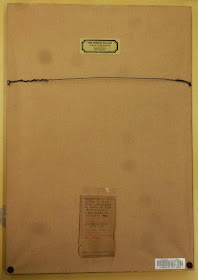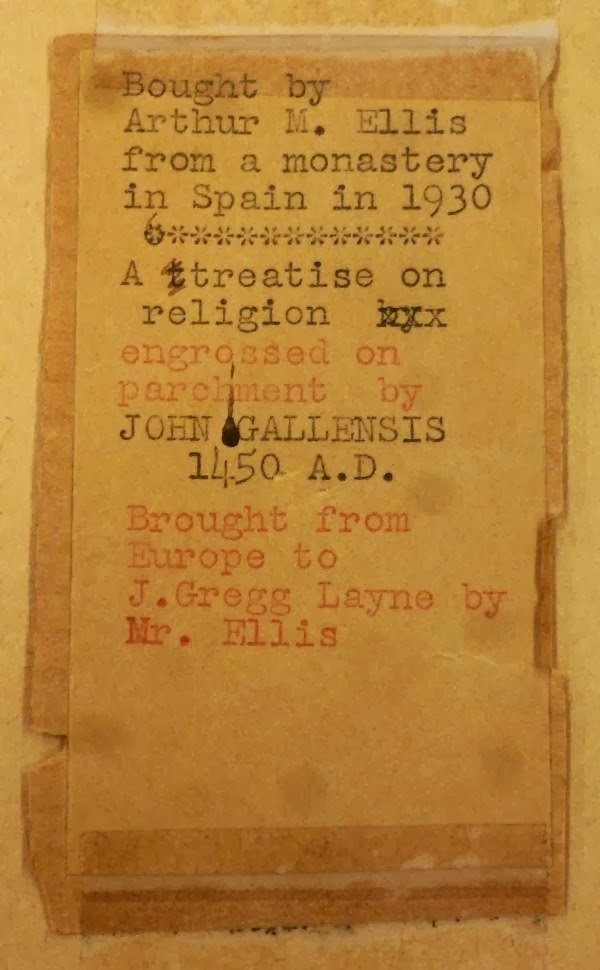One framed leaf, at Occidental College, provides information about their provenance, otherwise unavailable.
On the back of the frame is an old typescript label:
"Bought by / Arthur M. Ellis / from a monastery / in Spain in 1930 / ***/ A treatise on religionArthur M. Ellis (1875-1932) was an attorney, founding member, first Chairman, and later President of the bibliophile Zamorano Club, named after California's first printer.by/ engrossed on parchment by / JOHN GALLENSIS / 1450 A.D. / Bought from / Europe to / J.Gregg Layne by / Mr. Ellis"
 |
| Source |
 |
| Source |
The volume was doubtless imperfect when he bought it: where two sets of foliation both survive, the original red ink foliation differs from the 20th-century pencil foliation by 8, suggesting that a first quire of eight leaves was missing when the pencil foliation was supplied.
 |
| Foliations ".xxviij." and "20" |
The rubric above the illuminated initial begins "S[ecundu]m ca[pitulum], so here we have Part 1, Distinction 3, chapter 2. The rubric:

Two leaves are now in the collection of a UK private collector who has put them online at flickr.com. The first of these is from Part 1, Distinction 3, with running-headers "I P" and "III D", original red ink foliation "xxviii", and modern pencil folio "20"; with illuminated initials marking the beginnings of the 8th and 9th chapters:
The second is from Part 4, Distinction 3, with running-headers "IIII P" and "III D", with original red ink foliation cropped off, and apparently modern pencil folio "92", with illuminated initials marking the beginnings of the 5th and 6th chapters:
A leaf from Part 2, including chapters 4 and 5 of an unidentified Distinction is in a private collection in Japan:
A leaf with the illuminated initial to Part 1, Distinction 3, chapter 11 (folio ".xxx.") was sold by Old World Auctions in 2004:
"S[ecundu]m ca[pitulum]. Q[uod] princeps debet esse humilis deo et eccl[es]ie colens deu[m] v[er]e et eccl[es]ia[m] honora[n]s"closely matches an online printed edition:
Two leaves are now in the collection of a UK private collector who has put them online at flickr.com. The first of these is from Part 1, Distinction 3, with running-headers "I P" and "III D", original red ink foliation "xxviii", and modern pencil folio "20"; with illuminated initials marking the beginnings of the 8th and 9th chapters:
 |
| Recto |
 |
| Verso |
 |
| Recto |
 |
| Verso |
A leaf with the illuminated initial to Part 1, Distinction 3, chapter 11 (folio ".xxx.") was sold by Old World Auctions in 2004:
Also in 2004, another two leaves were offered in Maggs Bros, Catalogue 1366, European Bulletin No.23, [December 2004], nos.28-29, one with a six-line and five three-line initials, clearly from Part 4, including chapters 4-8 of an unidentified Distinction:
and another (no.29) with two three-line initials on the recto (not illustrated in the catalogue).
A leaf from Part 3, Distinction 6, with the illuminated initial for chapter 3, folio "lxxxvii[i ?]" was offered by Phillip J. Pirages, Catalogue 57, no. 75:
Pirages clearly had a very significant portion of the parent manuscript, as he offered a variety of leaves in three price ranges in 2004-2005: in Catalogue Fifty-One (2005), as item 128and another (no.29) with two three-line initials on the recto (not illustrated in the catalogue).
A leaf from Part 3, Distinction 6, with the illuminated initial for chapter 3, folio "lxxxvii[i ?]" was offered by Phillip J. Pirages, Catalogue 57, no. 75:
"$100 - $125 (for leaves without gold initials); $950 - $2,950 (for leaves with gold initials)
"$325 - $475 (for typical leaves); $85 - $95 (for leaves without gold initials); $750 - $5,500 (for specially decorated leaves)"of which two full-page reproductions are given in black and white, and a detail of another is reproduced in colour:
 |
| Initial to Part 4, Distinction 1, chapter 1 |
I would be glad if readers would bring further leaves to my attention.
[EDIT, 19 May 2014:]
Eric Johnson, Curator of Early Books and MSS at The Ohio State University, has kindly directed me to his very recent post on Facebook, concerning the acquisition by Ohio State of a leaf from the volume, in which he points out that the manuscript was still substantially intact, having 106 leaves and a 17th(?)-century binding, when sold at PBA Auctions, 12 June 2003, lot 155, "from the library of Arthur M. Ellis":















Two other leaves : https://www.kingalfredsnotebook.com/manuscript/726/
ReplyDeletehttps://www.antiquariat-kunsthandel.de/Handschriften/Lateinisches-Manuskript-Blatt-mit-Gold-Initialen-Kastilien-1400::898.html?XTCsid=i7kv319klc2tb3ci9q3kqjrd32
Hi Peter,
ReplyDeleteI just stumbled across another fol from this MS in the collections at the University of Reading: http://www.reading.ac.uk/adlib/Details/archive/110430099